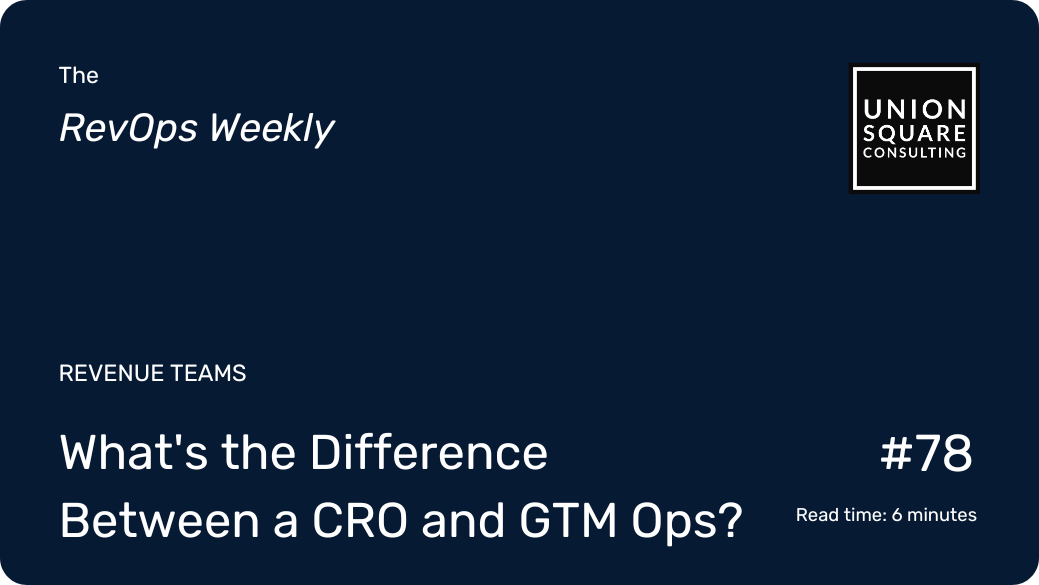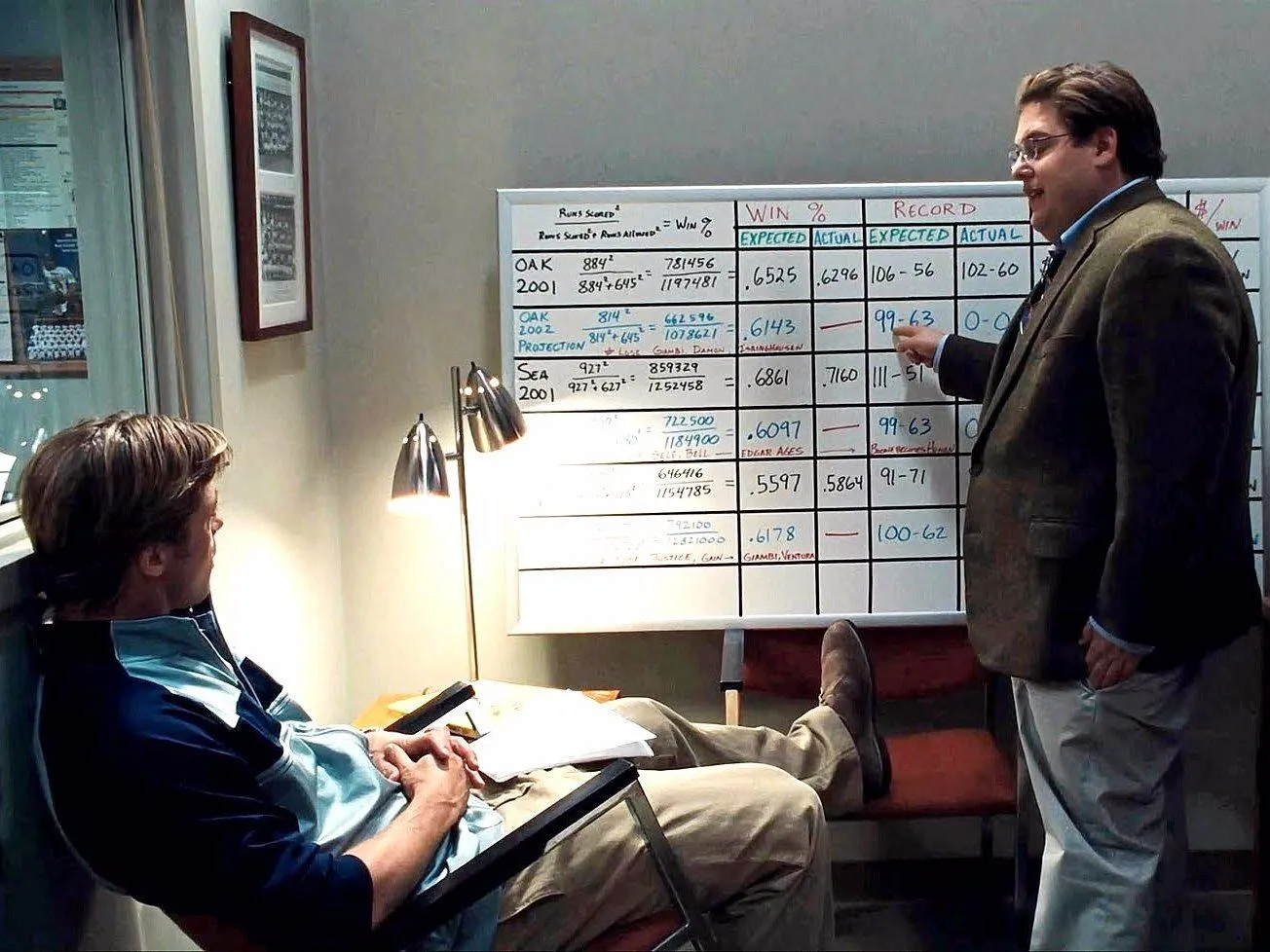
What’s the Difference Between a CRO and GTM Ops?
Read time: 6 minutesDownload the High-Res PDF: Click Here
In a scaling B2B SaaS company, there’s always a moment (or several) where revenue growth stalls – and the reason feels elusive. Pipeline looks promising, but deals aren’t closing (or not closing fast enough). Teams seem busy, but efficiency isn’t improving. Leadership wants better forecasting, but the numbers aren’t reliable or predictable.
This is often a point in time where a new CRO and or a new VP of GTM Strategy and Operations is hired. This is also most often when our team is hired. Sometimes we (or the new VP of GTM Strategy and Operations) are the first strategic resource brought in explicitly to help the CRO hit revenue targets and scale the business, not just manage systems.
Plenty of companies continue to operate without one of both of these roles. With enough GTM spend, some efforts will inevitably work. But for modern B2B SaaS companies looking to scale, having the right leadership can save years of growth struggles, tech debt, and process overhauls. If you’re PE-backed with high expectations, that may be time you can’t afford to lose.
Think of Moneyball
There’s no better visual for this than Moneyball. In the movie, Brad Pitt plays the GM of the Oakland A’s and he hires Jonah Hill to help him win more games through deep data analysis and player selection.
Like a CRO, Pitt builds and leads his team, spending most of his time recruiting people, managing leaders, managing up to the owner, managing his (very limited) budgets, putting out fires, and sometimes cracking the whip on people that don’t want to follow his vision. Like a CRO, this takes all his time and it’s what he’s best at.
This is where Hill comes in. He’s deep in the data and explains to Pitt a new way to build a winning team. He’s doing all the work Pitt doesn’t have time to do, and isn’t great at doing, so Pitt can do what he does best, with the data to make the right decisions, and the system in place to realize his vision. At a high level, this is what GTM Ops does.

Let’s break this down more:
The CRO: The Visionary of Revenue Strategy
A CRO is the visionary – responsible for setting the long-term revenue strategy and ensuring the entire go-to-market (GTM) function is aligned toward that goal.
This means:
Establishing GTM Strategy: The CRO ultimately decides how the company will attract, retain, and grow customers, via what channels, with what team, etc.
Cross-functional leadership: Aligning different departments to create a unified approach to customer acquisition and retention.
Owning revenue forecasting: Ensuring revenue targets are met by aligning sales, marketing, and customer success strategies.
Defining key metrics: Determining what success looks like and holding teams accountable for performance.
Building and leading the team: The CRO’s ultimate job is to build the GTM team and lead them to hit targets. This takes a LOT of time to recruit great people, put out fires, etc. This is also what CROs should be best at, and precisely why they need GTM Ops to help with other critical supporting work.
At a high level, the CRO is focused on answering one question: How do we scale revenue efficiently while ensuring long-term growth?
GTM Ops: The Engineer That Makes Strategy Functional
If the CRO is the visionary, GTM Ops is the engineer, responsible for helping the CRO turn that vision into a well designed GTM Engine with precision and efficiency.
This means:
Validating GTM Strategy: The CRO may think the ICP is this, the best channels are that, the team needs X more salespeople this year, etc. This should be validated with data and careful planning. That takes a lot of time. This is time the CRO does not have.
Building the Annual Plan: As an extension of strategy, we need a plan. The CRO, CEO, and board start with goals and top-down planning – but they need GTM Ops to do the heavy lifting to build a bottoms-up plan. Doing capacity planning, headcount planning, territories, targets, quotas, commissions, etc. takes immense time and effort. This, again, is not something the CRO should be tackling alone.
Driving operational excellence: The annual plan assumes certain operational performance metrics. To maintain or improve upon last year’s performance in each metric, someone needs to pay close attention to them and work on maintaining or improving the operational process that drives that performance.
Someone also needs to pay careful attention to the team’s execution of that process, especially as the team adds new people and evolves. The CRO leads the team, but they need someone analyzing their execution and performance.
Developing dashboards & analytics: Providing insights based on deep data analysis that help redirect strategy. Both the CRO and GTM Ops should be looking at the data every day, but ops should be doing 90% of the heavy lifting here.
Optimizing cross-functional processes: Eliminating inefficiencies in sales, marketing, and CS workflows. It takes time to analyze the data. It takes time to identify what to do about it. Then it takes even more time to define/redefine the process to see improvement. This, again, is where the CRO needs an engineer supporting them.
Building data-driven forecasting models: Ensuring forecasts are accurate and actionable. Everyone from the CRO to sales managers to reps needs to be on top of the data but ops can be an enormous help to police this and help ensure accurate forecasting is possible.
In short, GTM Ops ensures that strategy doesn’t just stay on paper – it gets operationalized and implemented at scale, in a way that adapts to incoming information and strategic shifts.
What Happens When You Don’t Have These Roles?
Without a CRO:
- Poor growth planning, resulting in missed targets
- Reactive decision-making instead of a proactive GTM strategy
- No clear revenue vision, leading to misalignment across teams
Without GTM Ops:
- Revenue strategy is poorly executed, leading to inefficiencies
- Sales, marketing, and CS operate in silos, reducing operational effectiveness
- Inconsistent processes result in data inconsistency and forecast inaccuracies
If your revenue growth is stalling, ask yourself: Do we have both the visionary and the execution engine in place?
Union Square Consulting provides the strategic and technical support CROs need to scale companies from $50M to $5B ARR. Unsure if we can help with your specific situation? We provide free 1:1 workshops to help you answer that question.
When you’re ready, here’s how we can help:
Get a Free 1:1 Revenue Efficiency Workshop
Get one of our Senior Revenue Strategists to yourself for 1 hour and leave with an initial plan to begin optimizing your go-to-market operations.
Hire Us!
Bring us on as your Strategic GTM and RevOps Team, for help with Growth Planning, GTM Process Design, Reporting/Data Insights and Systems Architecture.
Get more tips like these, sent right to your inbox.
Subscribe for fresh, relevant revenue growth tips delivered every week.